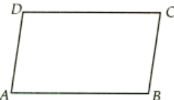Assertion and Reason for Areas of Parallelograms and Triangles Class 9 Math
Important QuestionsA
Answer
(a) Both assertion (A) and reason (R) are true and reason (R) is the correct explanation of assertion (A).(b) Both assertion (A) and reason (R) are true but reason (R) is not the correct explanation of assertion (A).
(c) Assertion (A) is true but reason (R) is false.
(d) Assertion (A) is false but reason (R) is true.
1
Reason (R): The area of a triangle is half of the area of a parallelogram on the same base and between the same parallels.
Answer
(a) Both Assertion and Reason are correct and Reason is the correct explanation of Assertion.
Area of ∆ = ½ area of rhombus
(Area of ∆)/(Area of rhombus) = ½ = 1 : 2
2
Reason (R): AAS criterion of congruency is used.
Answer
(a) Both assertion and reason are true and reason is the correct explanation of assertion.Construction : Join AC. Suppose AC and BD intersect at O. Draw AL ⊥ BD and CM ⊥ BD.
To prove : AO = OC
Proof : We have, area (∆ ABD) = area (∆ BDC)
Thus, ∆ s ABD and BDC are on the same base AB and have equal area. Therefore, their corresponding altitudes are equal i.e., AL = CM.
Now, in ∆ ALO and ∆ CMO, we have
∠1 = ∠2 [Vertically opposite angles]
∠ALO = ∠CMO [Each equal to 90°]
and AL = CM [Proved above]
∆ALO ≅ ∆CMO [AAS congruency]
AO = CO [C.P.C.T.]
3
Reason (R): Area of an equilateral triangle is given by √3/4 (side)2 .
Answer
(a) Both Assertion and Reason are correct and Reason is the correct explanation of Assertion.
Area of triangle = (√3/4) (8)2 cm2
= (√3/4) × 8 × 8 = 16√3 cm2
4
Reason (R): Area of rhombus is ½ × d1 × d2 , where d1 and d2 are lengths of the diagonals.
Answer
d) Assertion is false but reason is true.
Area of rhombus
= ½ × d1 × d2 ,
= ½ × 8 × 12 cm2 = 48 cm2
5
Reason (R): If a planar region formed by a figure R is made up of two non – overlapping planar regions formed by figures R1 and R2 , then area (R) = area(R1) + area(R2).
Answer
(b) Both assertion and reason are true but reason is not the correct explanation of assertion.
In ∆ PQS and ∆ QRS
We have, PQ = SR
PS = RQ [PQRS is a parallelogram]
and QS = SQ [Common side]
∆PQS ≅ ∆RSQ [By SSS congruency]
Hence, area (∆ PQS) = area (∆ RSQ)
6

Reason (R): If a triangle and a parallelogram are on the same base and between same parallels, then area of the triangle is equal to half of the parallelogram.
Answer
(d) Assertion is false but reason is true.
Area of (∆ ABD) = ½ area(parallelogram ABCD)
Area of parallelogram ABCD = 2 × Area of (∆ ABD)
= 2 × 24 = 48 cm2
7
Reason (R): Two parallelograms on the same base (or equal bases) and between the same parallel lines are equal in area.
Answer
(a) Both Assertion and Reason are correct and Reason is the correct explanation of Assertion.